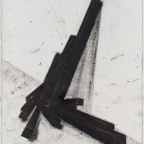Bernar Venet (b.1941, Château-Arnoux, France) is a conceptual artist considered by many to be the greatest living French sculptor. In this short film by Toby Amies, the renowned conceptual artist explores the meaning of art through the language of mathematics.
Bernar Venet doesn't like making art. In fact, he finds it terrible. What he does enjoy though, is having an idea. An idea he can get excited about, which makes him think "Oh my God, I want to do that". In this episode of Private View we find out more about the renowned conceptual artist, his practice, and the theoretical approach he applies to art making.
Throughout his decades spanning career, Venet's contribution to art has been radical. Focusing on rationality, a subject he expresses through the language of mathematics, the 81-year-old artist has worked to shift the perceptions of what is deemed a worthy and interesting subject for art.
With pieces ranging from paintings of mathematical equations, depicted on canvases varying in shape and colour, to geometric sculptures, Venet began the body of work that has gone on to define his career while creating work in New York in the 1960s. Since then, and now living back in his home country of France, Venet has developed his approach to art further by exploring the line - a fundamental geometrical object - as his subject.
Best known for creating immense sculptures of lines in their varying forms, his pieces appear to defy gravity with their mathematical precision and swooping configurations. These large steel objects typically sit on vast green landscapes, alluding to the fundamental and ultimately creative role mathematics plays in nature. The latest iteration of his body of work, entitled Angles, will soon be on view at Waddington Custot in London. Shown alongside drawings and smaller sculptures, this exhibition will offer a deeper understanding of the award winning artist's practice.
Entitled Hypotheses, this show will continue Venet's ongoing conversation between mathematics and art, a dialogue which has pushed the boundaries of art and defined new parameters for creativity. "I believe an artist's real role is to question everything that constitutes the nature and definition of art," he explains. "Putting mathematical language at the centre of my work allows me to introduce a subject to the artistic field that is neither abstract or figurative: it is freed from those traditions."






